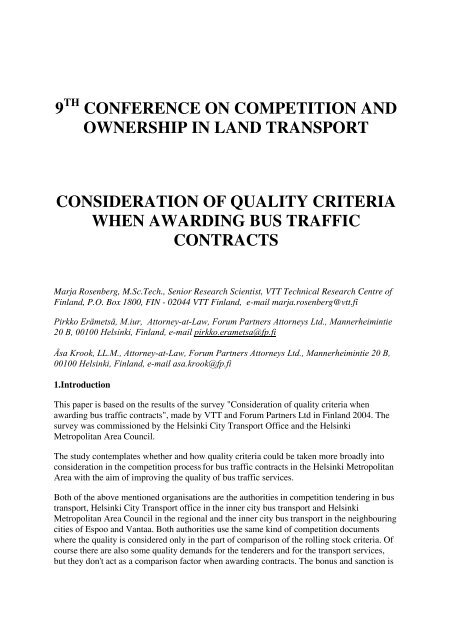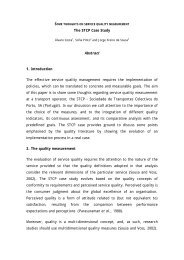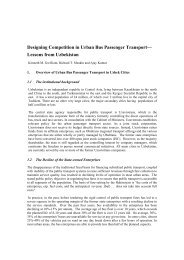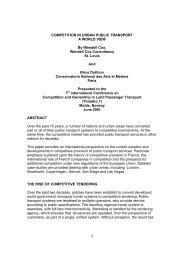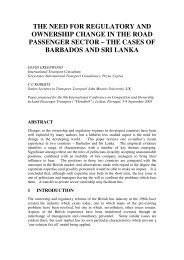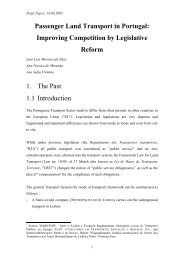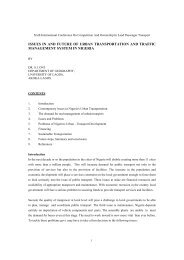Consideration of Quality Criteria when Awarding Bus Traffic Contracts
Consideration of Quality Criteria when Awarding Bus Traffic Contracts
Consideration of Quality Criteria when Awarding Bus Traffic Contracts
You also want an ePaper? Increase the reach of your titles
YUMPU automatically turns print PDFs into web optimized ePapers that Google loves.
9 TH CONFERENCE ON COMPETITION AND<br />
OWNERSHIP IN LAND TRANSPORT<br />
CONSIDERATION OF QUALITY CRITERIA<br />
WHEN AWARDING BUS TRAFFIC<br />
CONTRACTS<br />
Marja Rosenberg, M.Sc.Tech., Senior Research Scientist, VTT Technical Research Centre <strong>of</strong><br />
Finland, P.O. Box 1800, FIN - 02044 VTT Finland, e-mail marja.rosenberg@vtt.fi<br />
Pirkko Erämetsä, M.iur, Attorney-at-Law, Forum Partners Attorneys Ltd., Mannerheimintie<br />
20 B, 00100 Helsinki, Finland, e-mail pirkko.erametsa@fp.fi<br />
Åsa Krook, LL.M., Attorney-at-Law, Forum Partners Attorneys Ltd., Mannerheimintie 20 B,<br />
00100 Helsinki, Finland, e-mail asa.krook@fp.fi<br />
1.Introduction<br />
This paper is based on the results <strong>of</strong> the survey "<strong>Consideration</strong> <strong>of</strong> quality criteria <strong>when</strong><br />
awarding bus traffic contracts", made by VTT and Forum Partners Ltd in Finland 2004. The<br />
survey was commissioned by the Helsinki City Transport Office and the Helsinki<br />
Metropolitan Area Council.<br />
The study contemplates whether and how quality criteria could be taken more broadly into<br />
consideration in the competition process for bus traffic contracts in the Helsinki Metropolitan<br />
Area with the aim <strong>of</strong> improving the quality <strong>of</strong> bus traffic services.<br />
Both <strong>of</strong> the above mentioned organisations are the authorities in competition tendering in bus<br />
transport, Helsinki City Transport <strong>of</strong>fice in the inner city bus transport and Helsinki<br />
Metropolitan Area Council in the regional and the inner city bus transport in the neighbouring<br />
cities <strong>of</strong> Espoo and Vantaa. Both authorities use the same kind <strong>of</strong> competition documents<br />
where the quality is considered only in the part <strong>of</strong> comparison <strong>of</strong> the rolling stock criteria. Of<br />
course there are also some quality demands for the tenderers and for the transport services,<br />
but they don't act as a comparison factor <strong>when</strong> awarding contracts. The bonus and sanction is
in use as well, but the survey didn't aim to change this system, although it is accepted as a<br />
good way to achieve better quality in some parts <strong>of</strong> bus services.<br />
The authorities aim to catch more passengers by taking into account the quality factors as<br />
much as possible in every stage <strong>of</strong> providing service but also in the range <strong>of</strong> the costs <strong>of</strong> the<br />
bus transport to the municipalities.<br />
The study contemplates whether and how quality criteria could be taken more broadly into<br />
consideration in the competition process for the capital city area bus traffic contracts, <strong>when</strong><br />
the aim is to improve the quality <strong>of</strong> the bus traffic services.<br />
According to the current Finnish law regulating public procurement and the new EU<br />
directives ‘the lowest price ’and ‘the most economically advantageous tender’ can be applied<br />
as awarding criteria. In case ´the most economically advantageous tender criteria’ is applied<br />
only awarding criteria indicated in advance in the invitation for tenders may be taken into<br />
consideration. When evaluating the tenders now, the weight <strong>of</strong> the rolling stock criteria gives<br />
23 point in maximum and the price criteria 87 point in maximum.<br />
2. Experiences from Copenhagen and Gothenburg<br />
The contract awarding models used by the cities <strong>of</strong> Copenhagen and Gothenburg were<br />
contemplated as references for the purposes <strong>of</strong> the research. Copenhagen has introduced a<br />
new model in 2004 and Gothenburg has had its model in use for a few years.<br />
The model <strong>of</strong> Gothenburg is based on a so called Add Proval method. There are four stages in<br />
the method; first the interviews <strong>of</strong> the potential operators, second the competition tendering<br />
and evaluating the bits, third auditing the operators who got the contracts and finally the<br />
development <strong>of</strong> quality to achieve the promised standard. They use a consult in every stage <strong>of</strong><br />
the quality management process to insure the objectivity in the evaluation and auditing.<br />
The weightings in evaluating the most economically advantageous tender in Copenhagen and<br />
Gothenburg are as follows:<br />
Copenhagen Gothenburg<br />
price 40 % 60 %<br />
quality <strong>of</strong> services 35 % 20 %<br />
quality <strong>of</strong> buses 25 % 5 %<br />
references 10 %<br />
experience 5 %<br />
.
When awarding the contract, both the <strong>of</strong>fered price and how well the operator satisfies the<br />
quality requirements the author has made in the tendering documents are considered.<br />
Documents <strong>of</strong> call for tenders consist <strong>of</strong> requirements for transport services. The tenderers<br />
must fill the attachment templates to establish that the operator fulfills the requirements.<br />
The author has set a minimum quality index for every tender unit and every quality criteria.<br />
The tenderer <strong>of</strong>fers the quality index which the operator promises to get. The tendering<br />
documents also contain a detailed template which the operator must use to explain the quality<br />
process and several activities in the producing process. The quality is checked by continuing<br />
customer interviews. The author pays the bonus after one year’s contract time if the promised<br />
quality standard is gained.<br />
Both reference cities seemed to be very satisfied with their systems and had achieved a better<br />
quality in bus transport. Of course there had also been other actions to improve quality in<br />
public transport. There had not been any claims or problems with the operators to accept these<br />
methods, or any problems from the legal point <strong>of</strong> view.<br />
.<br />
3. Models in the Helsinki area<br />
Besides the experiences in the other cities the evaluating criteria used in tendering <strong>of</strong> cleaning<br />
services was examined as well.<br />
On the basis <strong>of</strong> these examples the survey points out that if the quality criteria are within<br />
comparison factors <strong>when</strong> evaluating the tenders, there are some common rules:<br />
- the quality indicators had to be quite few in number, transparent and unambiguous<br />
- the quality indicators had to be specified so that the evaluation could be done<br />
objectively and clearly.<br />
The following factors were found relevant in affecting the quality which the customer<br />
(passenger) recognises and the operator produces:<br />
- operators organisation and the development <strong>of</strong> the organisation<br />
- permanency, recruiting and education <strong>of</strong> staff<br />
- working conditions and internal information system<br />
- ways <strong>of</strong> cooperation<br />
- security and safety<br />
- flexibility in case <strong>of</strong> changes<br />
- operation in unusual situations<br />
- guaranteeing satisfying customer service<br />
- reaction to feedback<br />
- punctuality<br />
- developing <strong>of</strong> services.<br />
The study comes up with three different models based on which the tender procedures could<br />
be developed.
1. In 'the innovative model' awarding criteria are e.g. familiarising <strong>of</strong> the personnel with<br />
the traffic routes in question, handling <strong>of</strong> feedback, organising the flow <strong>of</strong> information,<br />
training programme for the personnel and language skills. The evaluation scale and<br />
qualification criteria for e.g. four different quality level classes are announced in the<br />
tender documents.<br />
This alternative model is more like the Gothenburg model.<br />
2. In 'the self evaluation model' the tenderer itself promises a quality level fulfilling or<br />
exceeding the minimum criteria set forth.<br />
This alternative is more like the Copenhagen model.<br />
3. In' the ordinary model' the awarding criteria can be the same as in the innovative<br />
model. The assessment <strong>of</strong> the criteria is based on the contracting entity's evaluation<br />
and determination between the tenders.<br />
In 'the innovative model' awarding criteria are e.g. familiarising <strong>of</strong> the personnel with the<br />
traffic routes in question, handling <strong>of</strong> feedback, organising the flow <strong>of</strong> information, training<br />
programme for the personnel and language skills. The evaluation scale and qualification<br />
criteria for e.g. four different quality level classes are announced in the tender documents.<br />
4. Assessment <strong>of</strong> the models<br />
Basically, from the legal point <strong>of</strong> view, different kinds <strong>of</strong> contract awarding models can be<br />
used.<br />
The study comes up with three different models for the development <strong>of</strong> the tender procedures.<br />
However, it should be generally kept in mind that if ´the most economically advantageous<br />
tender criterion’ is applied, only awarding criteria indicated in advance in the invitation for<br />
tenders may be taken into consideration. Furthermore, the tender documents shall clearly<br />
indicate the weighting <strong>of</strong> quality and price and their evaluation grounds. The evaluation <strong>of</strong> the<br />
quality criteria shall be linked to the subject matter <strong>of</strong> the contract, not to the tenderer.<br />
A -model<br />
Characteristic for the A –model, 'the innovative model' is that the weighting <strong>of</strong> the quality<br />
criteria is based upon a special scale. The valid legislation does not prevent this kind <strong>of</strong> price<br />
modelling. The awarding criteria set forth in this model, i.e. familiarising <strong>of</strong> the personnel
with the traffic routes in question, handling <strong>of</strong> feedback, organising the flow <strong>of</strong> information,<br />
training programme for the personnel and language skills, are basically also possible. It needs,<br />
however, to be taken into consideration that the criteria shall always fulfil the fundamental<br />
principles <strong>of</strong> the public procurement law and regulations - especially the transparency and<br />
equal treatment principles. The criterion shall be relevant for the procurement in question and<br />
be linked to the subject matter <strong>of</strong> the contract.<br />
B –model<br />
The speciality <strong>of</strong> Model B, 'the self evaluation model’ is that the tenderer itself evaluates its<br />
own quality and promises a quality level, fulfilling or exceeding the minimum criteria set<br />
forth.<br />
The minimum requirements, in numerical values, <strong>of</strong> the quality criteria are based on factors<br />
from customer satisfaction surveys and quality controls. Special attention needs to be paid<br />
thereupon that this system <strong>of</strong> setting a minimum level is equal for all the tenderers. It is also<br />
<strong>of</strong> importance to carefully control that the valuation system does not use customer satisfaction<br />
surveys and quality controls in such a way that tenderers would be discriminated or favoured<br />
by these. The risk in using customer satisfaction surveys is namely, among others, that<br />
historical facts, i.e. the orderer’s former experience <strong>of</strong> the tenderers will be used to the<br />
disadvantage <strong>of</strong> new players and hinder them from entering the market.<br />
Attention needs also to be paid thereupon that the evaluating criteria are linked to the subject<br />
matter <strong>of</strong> the contract, not to the tenderer.<br />
In respect <strong>of</strong> model B it is also <strong>of</strong> importance to ensure that the system with the numerical<br />
values does not lead to a situation where the criteria are not transparent. As the evaluation is<br />
based on the numerical values only, it is not possible to control afterwards whether the<br />
promises <strong>of</strong> the tenderers to fulfil a certain level <strong>of</strong> quality have based on acceptable<br />
groundings and whether the orderer has followed the principle <strong>of</strong> equal treatment in its<br />
evaluation.<br />
C -model<br />
In the C- model, ‘the ordinary model’ quality weighting is based upon the orderer’s<br />
requirements and descriptions <strong>of</strong> the subject matter <strong>of</strong> the tender. This should be legally<br />
possible throughout. However, in this model it is problematic that references and earlier<br />
experience <strong>of</strong> the tenderer are directly used as evaluation criteria.<br />
For example in the decision <strong>of</strong> the Supreme Administrative Court <strong>of</strong> Finland (decision <strong>of</strong><br />
KHO 12.12.2003, taltio 3202), the court doubted whether criteria such as references or former<br />
knowledge in local matters could be used as evaluation criteria. The Court <strong>of</strong> Justice has<br />
basically been <strong>of</strong> the same opinion as the Supreme Administrative Court (see judgement C-<br />
315 / 01 GAT) i.e., that references shall, normally, not be used as evaluation criteria but as<br />
eligibility criteria. Giving an average for newcomers (in the absence <strong>of</strong> the tenderer’s specific<br />
data) does not necessarily fulfil the juridical requirements <strong>of</strong> equal treatment. The average<br />
number should be applied in respect <strong>of</strong> all tenderers in order to achieve a sustainable solution.
About price/quality relation<br />
In Finland, there are neither special public procurement legislation nor rules to regulate the<br />
setting <strong>of</strong> the balance between price and quality <strong>when</strong> applying the economically most<br />
advantageous tender. In the literature it has been considered that the weight <strong>of</strong> the price<br />
should not be set too low, as this would not fulfil the requirement <strong>of</strong> the Finnish public<br />
procurement law (Laki julkisista hankinnoista 1505/92, 7 §) setting forth the economical<br />
criteria. In Finnish jurisdiction, it has been considered that in case the winning tender is<br />
clearly more expensive than the other ones, it should show respectively better quality<br />
(Decision <strong>of</strong> the Supreme Administrative Court 19.12.2002, taltio 3384), and also among<br />
others that depending on the procurement in question the price should have reasonable weight<br />
(e.g. decision <strong>of</strong> the Competition Counsel in Finland <strong>of</strong> 2.3.2001, 2/690/2000). This means<br />
that the price shall always have a reasonable role <strong>when</strong> applying the economically most<br />
advantageous tender.<br />
Summary<br />
From the legal point <strong>of</strong> view model A is the model with the least risk. In the light <strong>of</strong> present<br />
legislation and jurisdiction, special attention should be paid to the use <strong>of</strong> references as<br />
evaluation criteria (model C). These criteria should be used only restrictedly or should be left<br />
out completely. From the legal point <strong>of</strong> view, model B is the most complicated and risky<br />
model, especially in respect <strong>of</strong> setting the minimum requirements.<br />
Basically, all <strong>of</strong> the procedure models seem, from the juridical point <strong>of</strong> view, to be possible.<br />
The self-assessment model does, however, have some aspects to be considered further.<br />
Attention shall also be paid to the criteria applied in the models, e.g. the need for the criteria<br />
to be linked directly to the subject matter <strong>of</strong> the contract.<br />
The first task in achieving a stronger weight for the quality criteria is to specify those factors<br />
which are <strong>of</strong> importance from the quality point <strong>of</strong> view pursued by the contracting authority<br />
and the passengers and to verify the technical specifications i.e. the quality criteria linked to<br />
the invitation to tender. For the purpose <strong>of</strong> improving the quality, the target shall be creating a<br />
culture <strong>of</strong> co-operation between the contracting entity and the operators.<br />
5. Conclusions<br />
Both authors came to the conclusion that there is work to be done with quality factors to make<br />
the bus services more attractive. The main action, however, is not the contracts or the<br />
evaluating the quality factors in the tenders, but in the first hand the cooperation with<br />
authorities and the operators in different levels <strong>of</strong> organisations. The other thing is the<br />
tendering documents in which the quality demands set to the operator could be specified more<br />
properly than before. The public transport authority will specify the insistence to indicate
what the minimum quality stage they want to get from the operators and provide to customers<br />
is.<br />
The first task in achieving a stronger weight for the quality criteria is to specify those factors<br />
which are <strong>of</strong> importance from the quality point <strong>of</strong> view pursued by the contracting authority<br />
and the passengers and to verify the technical specifications i.e. the quality criteria linked to<br />
the invitation to tender. For the purpose <strong>of</strong> improving the quality, the target shall be creating a<br />
culture <strong>of</strong> co-operation between the contracting entity and the operators.<br />
Customer satisfaction assessments shall be developed as a part <strong>of</strong> the quality incentive<br />
system, among others by harmonising the measurable quality factors, their evaluation scales,<br />
weighting and determination principles. It is also <strong>of</strong> importance to take the results <strong>of</strong> the<br />
Customer satisfaction assessments and the feedback system into consideration <strong>when</strong><br />
developing the quality <strong>of</strong> the service.<br />
Regardless <strong>of</strong> how the awarding system <strong>of</strong> bus traffic contracts in respect <strong>of</strong> quality criteria<br />
will be developed in the future, a quality control system shall be created for the production <strong>of</strong><br />
transport services. The system shall be such that the contracting entities and operators are able<br />
to mutually accept it and to follow it as a part <strong>of</strong> their routine operations.


